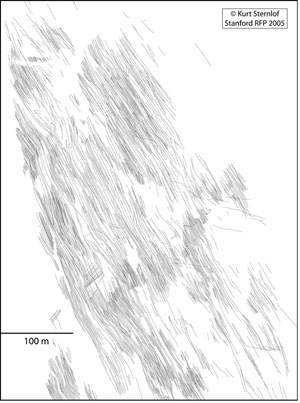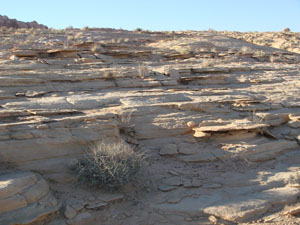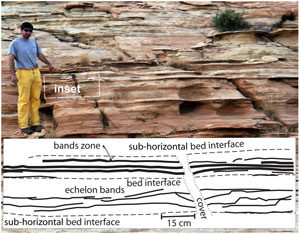|
Let's start with single sets of compaction bands. Figure 1 shows a set of compaction bands at high-angle to bedding in the Aztec Sandstone exposed at Valley of Fire State Park, Nevada. The set includes over 2,000 bands ranging from meters to hundreds of meters in length distributed over an area of about 35 acres as shown partially in the map in Figure 2 (Sternlof et al., 2005, 2006).
 | | Figure 1. A single set of compaction bands in the light-colored middle member of the Aztec sandstone exposed at Valley of Fire State Park, Nevada. View due North and the width of the photo at the bottom boundary is about 2.5 meters. |
 | | Figure 2. Trace map of the set of compaction bands in the photograph in Figure 1. The individual bands are at high angle to bedding and they range from a few meters to hundreds of meters in length distributed over an area of about 35 acres. From Sternlof and Karimi-Fard (2005). |
Figure 3 shows a set of compaction bands parallel or sub-parallel to the bedding which is nearly horizontal at this locality in Valley of Fire State Park (Aydin and Ahmadov, 2009; Deng and Aydin, 2012). It is difficult to differentiate these types of bands from depositional thin beds but some features are presented in Figure 4. These are: echelon segmentation, eye structures associated with coalescence of neighboring sub-parallel bands, zones of bands, and finally, bands cross-cutting bedding interfaces as marked on the inset map.
 | | Figure 3. A series of compaction bands parallel or sub-parallel to flat-lying beds in the Aztec sandstone, Valley of Fire State Park, Nevada. The bands have a high relief on the exposure surface. View due north and thickness of the exposure is about 20 meters. |
 | | Figure 4. Details of a set of bed-parallel, nearly horizontal compaction bands with trace maps (inset) showing features reminiscent of deformation bands reported in the literature. From Aydin and Ahmadov (2009). |
More complex compaction band distribution patterns and their impact on fluid flow is discussed by Deng et al., 2016).
| |
Aydin, A., Ahmadov, R., 2009. Bed-parallel compaction bands in Aeolian sandstone: Their identification, characterization and implications. Tectonophysics 479: 277-284, doi:10.1016/j.tecto.2009.08.033.
Deng, S., Aydin, A., 2012. Distribution of compaction bands in 3D in an aeolian sandstone: The role of cross-bed orientation. Tectonophysics 574–575: 204–218. http://dx.doi.org/10.1016/j.tecto.2012.08.037.
Deng, S., Jiang, R., Karimi-Fard, M., Aydin, A., 2016. Fluid-flow effects of compartmentalized distribution of compaction bands in an aeolian sandstone in three dimensions. Petroleum Geosciences, doi: 10.1144/petgeo2016-051.
Du Bernard, X., Eichhubl, P., Aydin, A., 2002. Dilation bands: a new form of localized failure in granular media. Geophysical Research Letters 29 (24): 2176 doi: 1029/2002GLO15966.
Sternlof, K.R., Karimi-Fard, M., 2005. Production-scale impacts of compaction bands in sandstone. Stanford Digital Repository. Available at: http://purl.stanford.edu/zw825wv2911.
Sternlof, K.R., Karimi-Fard, M., Pollard, D.D., Durlofsky, L.J., 2006. Flow and transport effects of compaction bands in sandstone at scales relevant to aquifer and reservior management. Water Resource Research 42: W07425, doi: 10.1029/2005WR004664.
|



